The trend dates back to the early 1980s with the opening of the country to foreign trade and the establishment of economic development zones, where foreign companies could establish production facilities. The pace picked up in the mid-1990s. The companies continue to come.
In general, HVACR companies are responding to the rapid commercial and industrial growth in China. The cost of shipping large air conditioning and refrigeration equipment from Western Hemisphere facilities to the Far East can be prohibitive, so opening production facilities in China gives those companies a competitive foothold in the region.
Currently most production is targeted for the insatiable appetite for cooling and refrigeration in China itself, though some companies anticipate reaching other areas of the Far East.
This spring I visited four plants in four different economic development zones. The number barely scratches the surface of our industry's presence in China, but it does give some indication of the ways familiar names are going to business in a new and somewhat unfamiliar marketplace. This is the first in a series of reports from those visits.
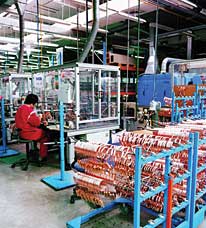
Danfoss Tianjin Is Part Of A Worldwide Mix
TIANJIN, China - It is a 70-mile drive along an expressway from Beijing to the Danfoss Ltd. production plant in the Wuqing Development Area near the city of Tianjin. The road is lined with recently planted trees which in a few years will block the arid landscape, an extension of the Gobi Desert partially surrounded by mountains. The trees also will provide a canopy on this straight shot of a road, as well as a partial barricade from summer winds.Development seems to operate at an accelerated pace in today's China. Industry grows at hyperspeed. A description of the Danfoss plant in April 2004 well may be outgrown in a few months. The company first registered in the Wuqing Development Area in 1995. In less than a year, it started production of radiator thermostats in what proved to be a temporary facility. Construction started on a new plant in 2001; the 125,000-square-foot facility opened in 2003.
When The News visited the plant in early April, construction was underway already on an additional 135,000 square feet set to open in a few months. Having reached space limits at that location, the company was eyeing two other sites nearby that it had previously secured for still more expansion.
In addition to radiator thermostats, products coming out of the plant include expansion valves, adapters, water valves, condensing units, shut-off valves, frequency converters, sight glasses, and check valves. The plant was adding lines for the production of scroll compressors and other products.
On-site supervision is under the direction of General Manager Claus Toennesen, who also is vice president of Danfoss China.
A handful of plant personnel are from Denmark, like Toennesen. The rest of the more than 300 employees are Chinese. Part of the equation is both putting bilingual Chinese into mid-management positions with plans to grow them into leadership roles, and encouraging the study of English as a Second Language (ESL), which is becoming almost a mania in mainland China.
In fact, the company's goal is to have the number of non-Chinese employees at the plant to be as low as possible. "This works best from both cost and cultural considerations. Chinese workers need Chinese foremen," said Toennesen.
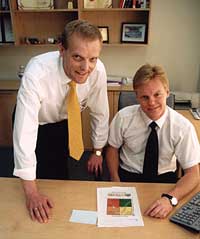
Karl Staerk, Danfoss sales president based in Baltimore, said the operation is simply part of the company's commitment to having a worldwide presence. Starting in the company's native Denmark, Danfoss spread to Germany and then through much of Europe, eventually reaching North America.
Staerk said three determinations are made regarding the location of factories and the products produced at each one. First of all, the company wants to be close to a market it wants to serve. "Danfoss wants factories in each region of the world," he said. "We want to have true global production on each continent. We are ahead of the game when we get closer to where designs are used."
The second factor is determining the products each factory will produce. "Each factory cannot produce a little bit of everything," Staerk said. "We want global factories for selected products."
The third factor is the cost of delivering product.
Vagn Helberg, president of RA Global Operations for Danfoss, reported a "growth in our RA [refrigeration and air conditioning segment] operations by 49.1 percent in 2002 over the previous year. This is the eighth consecutive year when we continued to enjoy such phenomenal growth."
He added that the company "has decided to open new production lines of scroll compressors and industrial refrigeration controls, to be produced in our factory in Wuqing."
The operation in the Wuqing industrial park now has about 300-plus employees. The company plans to have more than 650 on staff there by 2005. Employees work 40-hour weeks with three weeks of corporate-granted vacation and two additional weeks for holidays. The plant runs three shifts, although in some instances certain employees run equipment for six straight hours; four shifts are needed on such equipment. Most of the employees walk, bicycle, or motorcycle to work and live in local housing erected by developers of the industrial complex.
Toennesen noted that the same manufacturing equipment is used in the Tianjin factory that is used in Danfoss plants worldwide; each of the company's plants produces to the same ISO 9001 quality standards. The operation of Danfoss China is maintained, said Toennesen, "at a commendably high level of continuing training, frequent inspections, evaluations, and cross training of personnel." In addition to ISO 9001 certification, the Tianjin plant, like every Danfoss factory, also is certified to ISO 14001.
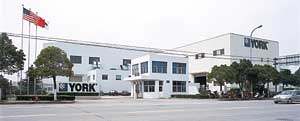
York's Wuxi Plant Fits Corporate Culture
WUXI, China - "Value oriented," "supply chain management," "quality control" - those terms are common in U.S. HVACR equipment manufacturing. They are also used in major manufacturing operations in China, as evident in a visit to York (Wuxi) Air Conditioning and Refrigeration Co. Ltd. The industrial complex is located in Wuxi, a city some 100 miles northwest of Shanghai.Andy Zhang, quality & manufacturing engineering manager at the plant, said adopting those corporate values "makes sure we produce the same high-quality products" as other York facilities. "We do not reinvent the wheel."
His comments were echoed by Vincent Lum, York director of marketing for Asia Pacific. Lum also said overall market opportunities and optimizing solutions are a couple of reasons for York locating plants in China. Part of that process, he noted, is the development of an onsite R&D team of 27 which, at the time of the visit in April 2004, was in the process of moving into a new, six-story building at the Wuxi complex. It also has massive plants for the construction of chillers and compressors for commercial-industrial applications. (Another plant in southern China is geared for residential projects.)
Lum said the research and development (R&D) commitment is an example of how the China operation follows the corporate mission statement and guidelines established at the world headquarters in York, Pa., as well as factoring in considerations for Asia, such as a more rapid response time. "We need to react quickly to the market," he said.
York has been producing chillers in China since 1996 as part of an 80/20 joint venture. The compressor production came on-line in 2000 and is wholly owned by York. In all, the facilities encompass some 200,000 square feet and employ more than 400 employees. An additional 300 work at York International [Northern Asia] Ltd. offices in downtown Shanghai. There are also some 30 York service centers throughout the country.
The company also has a dealer network, and Lum said the same strict standards that determine an authorized dealer in the states applies in China. "We have a tough selection process. Someone can claim to be a dealer and say he has a good relationship with a developer, but our dealers have to understand our technology and buy into our technology. We are not going for the quantity of dealers. We are going for the quality of the dealers," said Lum.
Zhang said the plant is capable of producing up to 300 large-tonnage chillers a month. It has ISO 9000, ISO 14000, and OHSAS 18000 certifications.
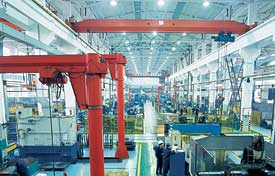
Stress is placed on obtaining and retaining good employees. Zhang said most of the employees have completed the equivalent of a high school education; 22 percent have bachelor's degrees. The company has an arrangement with a local university to allow its employees to pursue a master's degree.
Regular employee meetings keep them up to speed on corporate developments. Team-building programs and reward and recognition programs are used also.
Zhang reported "leap frog" growth each year for the plant. He said the company did $46.7 million in business in 2000 and $150 million in 2003. Currently about 90 percent of products are supplied to China. The remainder goes to other parts of Asia.
The product line includes reciprocating, screw, and centrifugal chillers. Newer products include water-cooled chillers, brine chillers for refrigeration, and an air-cooled chiller/heat pump. Zhang said the plant's chiller test stand is the largest in Asia, capable of handling systems of up to 2,000 tons and a range of voltages.
The company is starting its move to more R-134a units, even though the phaseout of R-22 in new equipment will not take place in China until 2030.
Lum said indoor air quality (IAQ) is taking on significance in China as the country has grown to the third-largest comfort cooling market in the world. The R&D operation, which was already underway in Wuxi prior to the completion of the new building, is dealing with that issue and power-related subjects.
Despite being 100 miles from Shanghai and half a world away from the corporate headquarters in Pennsylvania, Lum, like Zhang, stressed the importance of having the Wuxi plant considered an integral part of the company.
"The York culture really matters," he said. "It really makes a difference. The people of York have a very strong [corporate] culture belief.
"York can bring 130 years of success in the United States to China. But also we can influence the industry from here, as with our R&D center and the work we are doing with IAQ. This not only helps York as a business, but it helps the whole industry."
Greenheck Is A New Entry In China
KUNSHAN, China - Greenheck is one of the new kids on the block in China, in one of the newest industrial parks in the country.The Schofield, Wis.-based company shipped its first order of 20 belt-driven square inline fans on Oct. 27, 2003, less than a year after announcing plans to expand into the Far East.
The plant is located in an industrial park that pretty much shows what is happening with foreign investments in China. The Kunshan development area is one of about 30 authorized by the Chinese government. Some 3,000 foreign companies have operations in the complex. In the case of Kunshan, about 60 percent are companies from Taiwan; the others are from the United States and Europe. Hotels, housing, restaurants, and retail structures are springing up along with the factories. The entire area is being elaborately landscaped; up to 30 percent of the land will be set aside for green space.
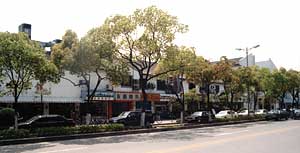
When it made that first historic shipment, Greenheck summarized its reason for establishing its first factory outside of the United States: "The new facility in China helps Greenheck deliver its products faster and more cost effectively to Chinese construction sites, by reducing overseas shipping costs and eliminating import duties.
"With construction booming throughout the country of 1.3 billion residents, China is expected to be the largest HVAC market in the world by 2005."
Larry Jackman, vice president of International Operations, said the establishment of the Chinese plant was actually an evolutionary process. Greenheck has had an agent in China for about seven years, and since that time has exported products from the United States to China primarily for the foreign direct investment market sector.
He noted that this segment ends up being only a small part of the total market potential. A growing market like China, he said, wants quality products and technical support, but also is looking at competitive prices and rapid availability. A U.S. company can provide the first two, but perhaps not the latter two without having a physical presence in China.
"Now we can gain access to a larger portion of the market and increase our market share," he said.
About two years ago, Jackman said Greenheck decided to aggressively "pursue our international business." The company hired regional directors for Latin America, Asia-Pacific, and the Middle East, "and put them closer to the market and the cultures." Then the company made arrangements for warehousing products in Singapore, Dubai, United Arab Emirates, and Monterrey, Mexico, as well as Shanghai.
The China factory was the next step.
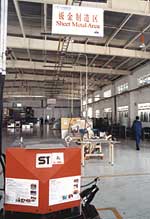
"We looked at manufacturing outside the United States and identified China as having the biggest potential," said Jackman. At the end of 2002, company officials began scouting out sites and decided to set up the plant to be wholly owned by Greenheck, an option that has recently become available to foreign companies. The first generation of companies entered the market as part of joint ventures.
By the spring of 2003, Greenheck had settled on a structure in Kunshan available for lease and hired Gary Xu as general manager. That summer, equipment was brought in from Wisconsin. The first order was shipped that fall.
Today, some 30 people work at the site. Hiring is done through newspaper ads and job fairs, then Greenheck provides training. A technical director from the Wisconsin headquarters travels back and forth to provide assistance. Xu said he works with employees to educate them on proper manufacturing processes.
"We want a zero defect mentality. We want to ship perfect products from here," said Jackman. "We want products built to Greenheck quality, whether it's the plant in China or one of the plants in the United States."
The main products currently coming off the assembly lines in China are belt-driven square in-line fans, control dampers, dampers for life safety applications, and utility fans. About 90 percent are for use in China with the remainder going to Thailand, Hong Kong, and the Philippines. Xu and others at the Kunshan plant also are visiting OEMs in China and the Asia Pacific region, drawing attention to the product line.
At the time of my visit in April, the company was in the final stages of preparing for ISO 9000 certification, a recognition gaining more and more acceptance in China. The company is preparing a 224-page catalog in Chinese, describing Greenheck and its products, also.
Look for more reports from China in future issues of The News.
Sidebar: HVACR For Shanghai Cultural Facilities
Shanghai, China's largest city, has witnessed enormous cultural development through the years. It now has a number of facilities for the arts. The newest ones not only showcase the arts and architecture, but also the latest engineering technologies.Carrier Corp. is working with Shanghai officials to provide comfort cooling with attention to the environment. The manufacturer will supply 39 CBF Series air handlers to the Shanghai Oriental Arts Center, which was designed by French architect Paul Andrew.
Covering an area of 23,000 square meters in Shanghai's Pudong New Area, the center will hold 3,400 in its three theaters.
The units were chosen for their lower noise levels, vibration, condensed water, and wind leakage, according to company officials. The units are said to surpass China's national equipment standards and reach Europe's EN 1886 Standard, which addresses the mechanical performance of air-handling units.
Officials with the Shanghai Pudong Archives & Exhibition Hall also selected two Carrier 19XR750 centrifugal chillers and a 30 HXC screw chiller, for a total of more than 1,800 tons of refrigeration.
When they are completed, the archives and exhibition hall will house historical documents that record the development of the city's new economic area.
The chillers were chosen because of their operating efficiency and use of HFC-134, which satisfies the demand for "green" buildings in China.
Carrier also said it offers long-term maintenance services. The central air conditioning system has been installed with Carrier Comfort Network (CCN), which links the HVAC equipment to the building's other supporting facilities.
The manufacturer "has been actively involved in Shanghai's cultural development in recent years," said James Ng, vice president of Carrier China Operations. Ng is in charge of the sales and distribution network of Carrier products in China.
Publication date: 06/28/2004


Report Abusive Comment